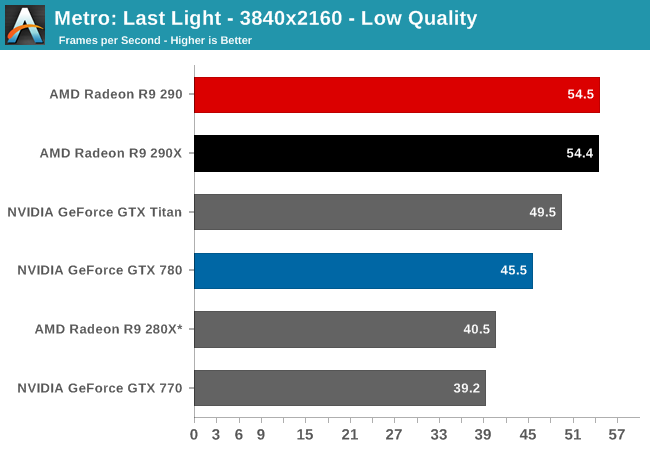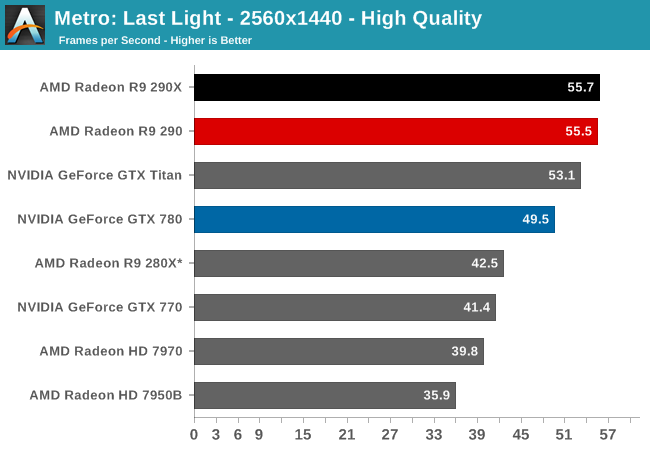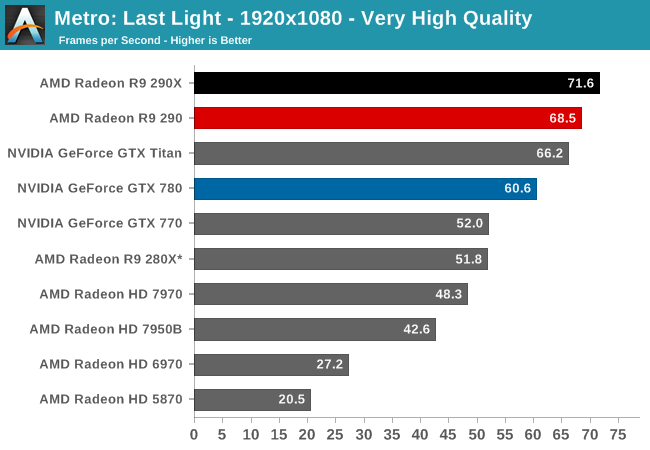The AMD Radeon R9 290 Review
by Ryan Smith on November 5, 2013 12:01 AM EST- Posted in
- GPUs
- AMD
- Radeon
- Hawaii
- Radeon 200
Metro: Last Light
As always, kicking off our look at performance is 4A Games’ latest entry in their Metro series of subterranean shooters, Metro: Last Light. The original Metro: 2033 was a graphically punishing game for its time and Metro: Last Light is in its own right too. On the other hand it scales well with resolution and quality settings, so it’s still playable on lower end hardware.



For the bulk of our analysis we’re going to be focusing on our 2560x1440 results, as monitors at this resolution will be what we expect the 290 to be primarily used with. A single 290 may have the horsepower to drive 4K in at least some situations, but given the current costs of 4K monitors that’s going to be a much different usage scenario. The significant quality tradeoff for making 4K playable on a single card means that it makes far more sense to double up on GPUs, given the fact that even a pair of 290Xs would still be a fraction of the cost of a 4K, 60Hz monitor.
With that said, there are a couple of things that should be immediately obvious when looking at the performance of the 290.
- It’s incredibly fast for the price.
- Its performance is at times extremely close to the 290X
To get right to the point, because of AMD’s fan speed modification the 290 doesn’t throttle in any of our games, not even Metro or Crysis 3. The 290X in comparison sees significant throttling in both of those games, and as a result once fully warmed up the 290X is operating at clockspeeds well below its 1000MHz boost clock, or even the 290’s 947MHz boost clock. As a result rather than having a 5% clockspeed deficit as the official specs for these cards would indicate, the 290 for all intents and purposes clocks higher than the 290X. Which means that its clockspeed advantage is now offsetting the loss of shader/texturing performance due to the CU reduction, while providing a clockspeed greater than the 290X for the equally configured front-end and back-end. In practice this means that 290 has over 100% of 290X’s ROP/geometry performance, 100% of the memory bandwidth, and at least 91% of the shading performance.
So in games where we’re not significantly shader bound, and Metro at 2560 appears to be one such case, the 290 can trade blows with the 290X despite its inherent disadvantage. Now as we’ll see this is not going to be the case in every game, as not every game GPU bound in the same manner and not every game throttles on the 290X by the same degree, but it sets up a very interesting performance scenario. By pushing the 290 this hard, and by throwing any noise considerations out the window, AMD has created a card that can not only threaten the GTX 780, but can threaten the 290X too. As we’ll see by the end of our benchmarks, the 290 is only going to trail the 290X by an average of 3% at 2560x1440.
Anyhow, looking at Metro it’s a very strong start for the 290. At 55.5fps it’s essentially tied with the 290X and 12% ahead of the GTX 780. Or to make a comparison against the cards it’s actually priced closer to, the 290 is 34% faster than the GTX 770 and 31% faster than the 280X. AMD’s performance advantage will come crashing down once we revisit the power and noise aspects of the card, but looking at raw performance it’s going to look very good for the 290.










295 Comments
View All Comments
just4U - Wednesday, November 6, 2013 - link
You have to ask yourself is Ryan biased with Nvidia or AMD... or maybe it's simply just his tolerance for noise that is the issue.Anyway.. people buying these cards will have some options. For me the 95C is a no go as is the noise. Something I'd tolerate until a good aftermarket solution could be implemented. AMD and Nvidia (until their titan reference cooler) have always been a little meh.. with reference coolers. We all know this..
My last two cards have been AMD ones and if I was in the market for a card today I'd go straight for the Nvidia 780. Not because of it's speeds, certainly not because of its drivers, and not because I am a fan. I simply like their kickass reference cooler and games bundle.
Im not in the market though lol. Quite happy with my Radeon 7870.. and not looking to upgrade yet.
jbs181818 - Thursday, November 7, 2013 - link
With all that power consumption, what size PSU is required? Assuming 1 GPU and a haswell CPU, 1 SSD.dwade123 - Thursday, November 7, 2013 - link
290x doesn't make sense when the cheaper 290 performs almost identical. And neither can max out Crysis 3. Gamers are better off waiting for real next-gen cards like Maxwell, and with next-gen console ports coming in 2014 suggests it is common sense to do so.polaco - Tuesday, November 12, 2013 - link
"neither can max out Crysis 3" what the hell are you talking about?52 fps at 2560x1440 HQ + FXAA
77 fps at 1920x1080 HQ + FXAA
with that line of thinking then nor 780 or Titan are worthy since fps diff is minimal
"gamers are better off waiting for real next-gen cards like Maxwell"
well, 290 and 290X are AMD true next gen cards, maybe you feel fooled by having bought a 780 for almost 700 bucks and then you feel like Maxwell will relief that pain, or maybe you work for NVidia marketing deparment... for the time NVidia came out with it AMD will be pushing their next gen too, will you recommend waiting then too? so we wait forever then uh?
"and with next-gen console ports coming in 2014 suggests it is common sense to do so"
you mean to wait for NVidia card to run games that will be optimized to AMD hardware that is inside every next gen console?
please go to see a doctor....
TempAccount007 - Saturday, November 9, 2013 - link
Who the hell uses a reference cooler on any AMD card? The only people that buy reference cards are those who are going to water cool them.NA1NSXR - Monday, November 11, 2013 - link
If I was in the market for a card I'd wait until the aftermarket cooler designs come out. Should make the noise and temp situation a little more bearable. Still, the proprietary nVidia value-adds like HBAO+, adative vsync, TXAA, etc. are hard to give up for me. It is a hard call. If the 780 was only $50 more than the 290 I'd take the 780, but since the difference is $100....I don't know. Really tough call.beck2448 - Tuesday, November 12, 2013 - link
Too noisy and hot.devilskreed - Tuesday, November 12, 2013 - link
Hail High AMD..The gamers saviour!!!Hail High AMD..The price/performance king
Hail High AMD..The peoples choice..
Healthy competition from AMD's side,i stopped buying nvidia after 8800GT :p purely due to price/performance benefits that AMD offers..
bloodbones - Thursday, November 14, 2013 - link
The battle between amd ex ati and nvidia has been around since i was 18 years old and i am 30 now. Over the years i have try a huge numbers of video cards from both companies and the only conclusion is that things have always been the same, nothing change over the years: more or less the same performance and:Nvidia = more expensive cards but more quality cards, lower noise levels lower temps
Ati/Amd = cheaper cards with higher noise levels higher temps
Period.
horse07 - Thursday, November 14, 2013 - link
Guys, when will you update the 2013 GPU benchmarks with the recent R7/R9 and 700 series?